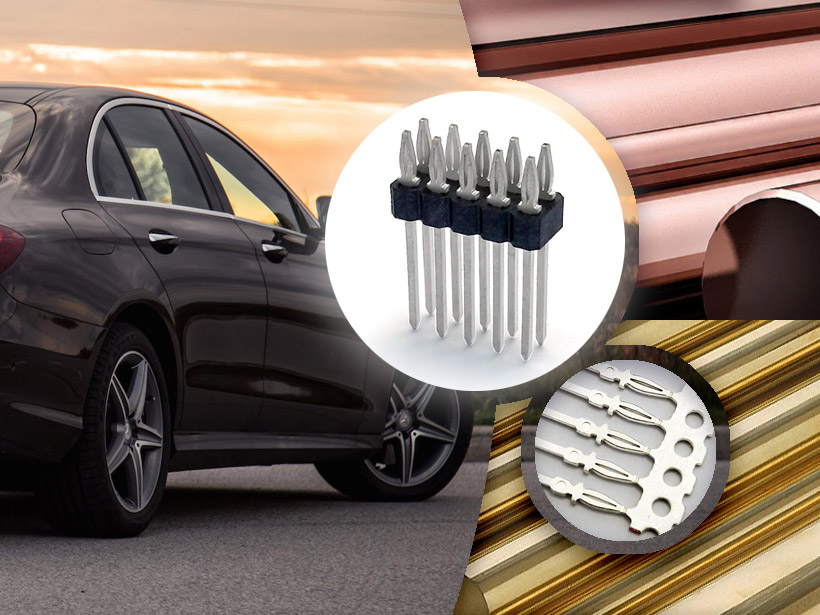Conductive Performance Analysis of Automotive Connectors

Automotive connectors are used for power and signal transmission in automotive interiors, with different forms and structures due to the needs of the interior structure of the car, but mainly including accessories, housings, pins, sockets, and terminals. The terminal is the core of the connector, which ensures electrical connection and signal transmission with extremely strict standards in terms of mechanical performance, electrical performance and vibration resistance. With the increasing demands for terminal stability and safety, the design and material coating of automotive connector terminals are also constantly improving.
This article will briefly analyze the factors affecting the electrical conductivity of automotive connectors from two aspects: terminal structural design and the materials used.
Factor 1: The structural design of automotive connector terminal
The basic principle that must be observed before designing the terminal is to meet the transmission function of the automotive connector terminal. In order to strictly control the design and production cost, the amount of raw materials used in terminal production must be limited.
By analyzing its production process, it is found that there is a bottleneck structure in the terminal, namely a cross-sectional structure in the conductive surface. This structure has a great influence on the current-carrying capacity, thus affecting the conductivity of the terminal.
Generally, two basic requirements are put forward for the conductive surface of automotive connector terminals: one is to ensure the good performance of the pin and socket terminals. The surface of the pin must be highly smooth, and the roughness is less than or equal to 0.8. The second one is based on the fact that the most important function of the automotive connector is the transmission of current and signals, therefore, during the design and production process, the cross section must be properly processed and controlled to ensure that the conductivity of the terminal is not damaged.
Factor 2. The materials used in automotive connector terminals
At present, based on the production level of automotive connectors in China, it is necessary to carefully select the materials used in terminal production from the perspective of economy and function. The commonly used materials include brass and beryllium bronze. Brass has electrical properties superior to beryllium bronze, but less elastic advantages than brass.
Due to the different structures of plug terminals and socket terminals, brass is more suitable for the production of plug terminals with a current of less than 50A, which can effectively ensure electrical conductivity. Socket terminals are usually jack terminals and usually consist of two parts: an elastic reed part and a brass terminal that wraps around it. This can not only ensure the elasticity of the socket, but also ensure good electrical conductivity of the terminal.
Generally speaking, the pin terminals and jack terminals should be kept well-grounded when the plug sockets of car connectors are inserted. In the state of car collision, the stability of the pin terminals and jack terminals should be ensured, and the vibration and shock resistance requirements of the connector should be met. For this reason, heat treatment must be carried out on the elastic reed parts to improve the flexibility of the reed and reduce elastic fatigue.
With the development of the automotive industry, connector terminals will gradually develop towards small size, high precision and stronger current transmission capability. However, in addition to the influence of the terminal design and material selection analyzed above, the electrical conductivity of the automotive connector terminal is also affected by various factors, such as the rationality of the structure design, the contact pressure of the product and so on. Therefore, in the process of designing and producing automotive connector terminals, we should pay attention to the reasons for these influencing factors from many aspects to ensure the quality and electrical conductivity of the product, thereby improving the safety and stability of the car.
This article will briefly analyze the factors affecting the electrical conductivity of automotive connectors from two aspects: terminal structural design and the materials used.
Factor 1: The structural design of automotive connector terminal
The basic principle that must be observed before designing the terminal is to meet the transmission function of the automotive connector terminal. In order to strictly control the design and production cost, the amount of raw materials used in terminal production must be limited.
By analyzing its production process, it is found that there is a bottleneck structure in the terminal, namely a cross-sectional structure in the conductive surface. This structure has a great influence on the current-carrying capacity, thus affecting the conductivity of the terminal.
Generally, two basic requirements are put forward for the conductive surface of automotive connector terminals: one is to ensure the good performance of the pin and socket terminals. The surface of the pin must be highly smooth, and the roughness is less than or equal to 0.8. The second one is based on the fact that the most important function of the automotive connector is the transmission of current and signals, therefore, during the design and production process, the cross section must be properly processed and controlled to ensure that the conductivity of the terminal is not damaged.
Factor 2. The materials used in automotive connector terminals
At present, based on the production level of automotive connectors in China, it is necessary to carefully select the materials used in terminal production from the perspective of economy and function. The commonly used materials include brass and beryllium bronze. Brass has electrical properties superior to beryllium bronze, but less elastic advantages than brass.
Due to the different structures of plug terminals and socket terminals, brass is more suitable for the production of plug terminals with a current of less than 50A, which can effectively ensure electrical conductivity. Socket terminals are usually jack terminals and usually consist of two parts: an elastic reed part and a brass terminal that wraps around it. This can not only ensure the elasticity of the socket, but also ensure good electrical conductivity of the terminal.
Generally speaking, the pin terminals and jack terminals should be kept well-grounded when the plug sockets of car connectors are inserted. In the state of car collision, the stability of the pin terminals and jack terminals should be ensured, and the vibration and shock resistance requirements of the connector should be met. For this reason, heat treatment must be carried out on the elastic reed parts to improve the flexibility of the reed and reduce elastic fatigue.
With the development of the automotive industry, connector terminals will gradually develop towards small size, high precision and stronger current transmission capability. However, in addition to the influence of the terminal design and material selection analyzed above, the electrical conductivity of the automotive connector terminal is also affected by various factors, such as the rationality of the structure design, the contact pressure of the product and so on. Therefore, in the process of designing and producing automotive connector terminals, we should pay attention to the reasons for these influencing factors from many aspects to ensure the quality and electrical conductivity of the product, thereby improving the safety and stability of the car.





